Sherali Zeadally
Senior Member, IEEE
DroneOptiNet: A Framework for Optimal Drone-based Load Redistribution Mechanism for 5G and Beyond Solar Small Cell Networks
Nov 21, 2023



Abstract:The power requirements posed by the fifth-generation and beyond cellular networks are an important constraint in network deployment and require energy-efficient solutions. In this work, we propose a novel user load transfer approach using airborne base stations (BS), mounted on drones, for reliable and secure power redistribution across the micro-grid network comprising green small cell BSs. Depending on the user density and the availability of an aerial BS, the energy requirement of a cell with an energy deficit is accommodated by migrating the aerial BS from a high-energy to a low-energy cell. The proposed hybrid drone-based framework integrates long short-term memory with unique cost functions using an evolutionary neural network for drones and BSs, and efficiently manages energy and load redistribution. The proposed algorithm reduces power outages at BSs and maintains consistent throughput stability, thereby demonstrating its capability to boost the reliability and robustness of wireless communication systems.
Beyond Reality: The Pivotal Role of Generative AI in the Metaverse
Jul 28, 2023



Abstract:Imagine stepping into a virtual world that's as rich, dynamic, and interactive as our physical one. This is the promise of the Metaverse, and it's being brought to life by the transformative power of Generative Artificial Intelligence (AI). This paper offers a comprehensive exploration of how generative AI technologies are shaping the Metaverse, transforming it into a dynamic, immersive, and interactive virtual world. We delve into the applications of text generation models like ChatGPT and GPT-3, which are enhancing conversational interfaces with AI-generated characters. We explore the role of image generation models such as DALL-E and MidJourney in creating visually stunning and diverse content. We also examine the potential of 3D model generation technologies like Point-E and Lumirithmic in creating realistic virtual objects that enrich the Metaverse experience. But the journey doesn't stop there. We also address the challenges and ethical considerations of implementing these technologies in the Metaverse, offering insights into the balance between user control and AI automation. This paper is not just a study, but a guide to the future of the Metaverse, offering readers a roadmap to harnessing the power of generative AI in creating immersive virtual worlds.
DeepMA: End-to-end Deep Multiple Access for Wireless Image Transmission in Semantic Communication
Mar 21, 2023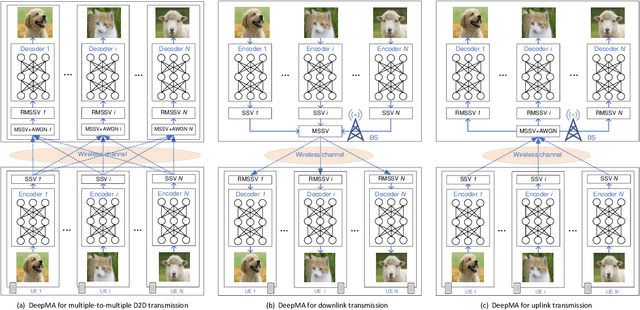


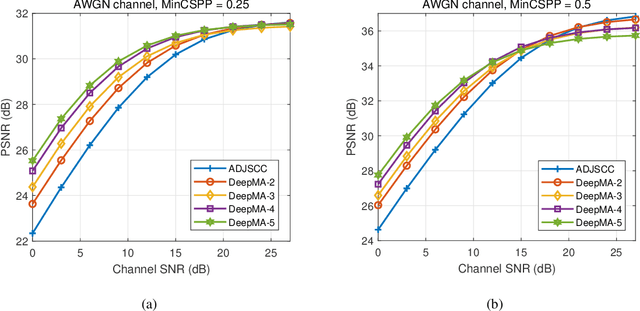
Abstract:Semantic communication is a new paradigm that exploits deep learning models to enable end-to-end communications processes, and recent studies have shown that it can achieve better noise resiliency compared with traditional communication schemes in a low signal-to-noise (SNR) regime. To achieve multiple access in semantic communication, we propose a deep learning-based multiple access (DeepMA) method by training semantic communication models with the abilities of joint source-channel coding (JSCC) and orthogonal signal modulation. DeepMA is achieved by a DeepMA network (DMANet), which is comprised of several independent encoder-decoder pairs (EDPs), and the DeepMA encoders can encode the input data as mutually orthogonal semantic symbol vectors (SSVs) such that the DeepMA decoders can recover their own target data from a received mixed SSV (MSSV) superposed by multiple SSV components transmitted from different encoders. We describe frameworks of DeepMA in wireless device-to-device (D2D), downlink, and uplink channel multiplexing scenarios, along with the training algorithm. We evaluate the performance of the proposed DeepMA in wireless image transmission tasks and compare its performance with the attention module-based deep JSCC (ADJSCC) method and conventional communication schemes using better portable graphics (BPG) and Low-density parity-check code (LDPC). The results obtained show that the proposed DeepMA can achieve effective, flexible, and privacy-preserving channel multiplexing process, and demonstrate that our proposed DeepMA approach can yield comparable bandwidth efficiency compared with conventional multiple access schemes.
Intelligent and Secure Radio Environments for 6G Vehicular Aided HetNets: Key Opportunities and Challenges
Oct 05, 2022



Abstract:Reconfigurable meta-surfaces are emerging as a novel and revolutionizing technology to enable intelligent wireless environments. Due to the low cost, improved efficiency, and passive nature of reflecting elements, it is becoming possible to program and control the wireless environment. Since wireless physical layer technologies can generally adapt to the wireless environment, their combination with reconfigurable surfaces and deep learning approaches can open new avenues for achieving secure 6G vehicular aided heterogeneous networks (HetNets). Motivated by these appealing advantages, this work provides an intelligent and secure radio environment (ISRE) paradigm for 6G vehicular aided HetNets. We present an overview of enabling technologies for ISRE-based 6G vehicular aided HetNets. We discuss features, design goals, and applications of such networks. Next, we outline new opportunities provided by ISRE-based 6G vehicular HetNets and we present a case study using the contextual bandit approach in terms of best IRS for secure communications. Finally, we discuss some future research opportunities.
Power and Performance Efficient SDN-Enabled Fog Architecture
May 30, 2021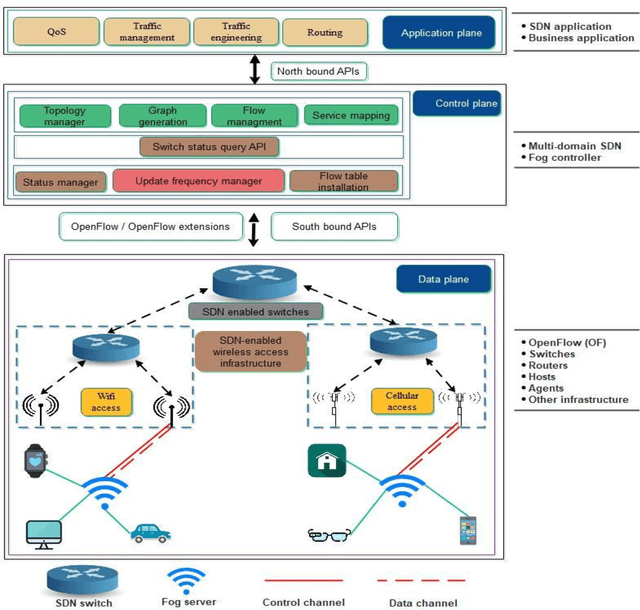
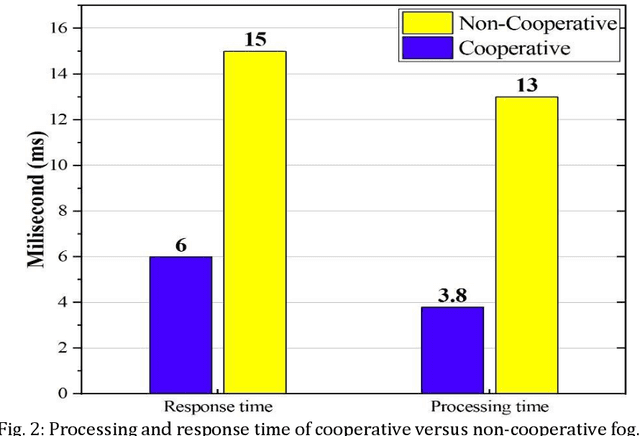
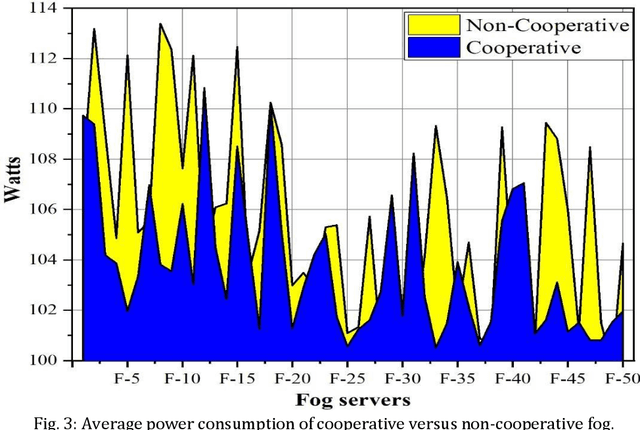
Abstract:Software Defined Networks (SDNs) have dramatically simplified network management. However, enabling pure SDNs to respond in real-time while handling massive amounts of data still remains a challenging task. In contrast, fog computing has strong potential to serve large surges of data in real-time. SDN control plane enables innovation, and greatly simplifies network operations and management thereby providing a promising solution to implement energy and performance aware SDN-enabled fog computing. Besides, power efficiency and performance evaluation in SDN-enabled fog computing is an area that has not yet been fully explored by the research community. We present a novel SDN-enabled fog architecture to improve power efficacy and performance by leveraging cooperative and non-cooperative policy-based computing. Preliminary results from extensive simulation demonstrate an improvement in the power utilization as well as the overall performance (i.e., processing time, response time). Finally, we discuss several open research issues that need further investigation in the future.
Machine learning and data analytics for the IoT
Jun 30, 2020



Abstract:The Internet of Things (IoT) applications have grown in exorbitant numbers, generating a large amount of data required for intelligent data processing. However, the varying IoT infrastructures (i.e., cloud, edge, fog) and the limitations of the IoT application layer protocols in transmitting/receiving messages become the barriers in creating intelligent IoT applications. These barriers prevent current intelligent IoT applications to adaptively learn from other IoT applications. In this paper, we critically review how IoT-generated data are processed for machine learning analysis and highlight the current challenges in furthering intelligent solutions in the IoT environment. Furthermore, we propose a framework to enable IoT applications to adaptively learn from other IoT applications and present a case study in how the framework can be applied to the real studies in the literature. Finally, we discuss the key factors that have an impact on future intelligent applications for the IoT.
 Add to Chrome
Add to Chrome Add to Firefox
Add to Firefox Add to Edge
Add to Edge